Continuing our trek through northern Argentina, we abandoned the Dry Chaco of Cordoba and ascended into the forested, lower foothills of the Andes. Our next base was the touristy mountain town of Tafi del Valle; this would be our first venture into the Andes. The town is situated between three astounding birding hotspots: the massive lake called Dique la Angostura, around which the town is built, the lush Yungas cloud-forest along the Rio Sosa to the south, and Infiernillo pass to the north. We birded the Yungas forest (our first proper forest birding of the trip) and the river as we ascended towards Tafi from the south, with the main highlights being a pair of Rufous-throated Dippers, two sightings of Tucuman Parrot (including one doing its wheeling display flight) and a couple of the endemic Yellow-striped Brushfinch. Other notable sightings were my first ever Swallow-tailed Kites, beautiful Plush-crested Jays feeding around the picnic sites along the pass, two skittish Torrent Ducks, our first views of Yungas Guan and a bustling foraging flock that included Highland Elaenia and Golden-rumped Euphonia.
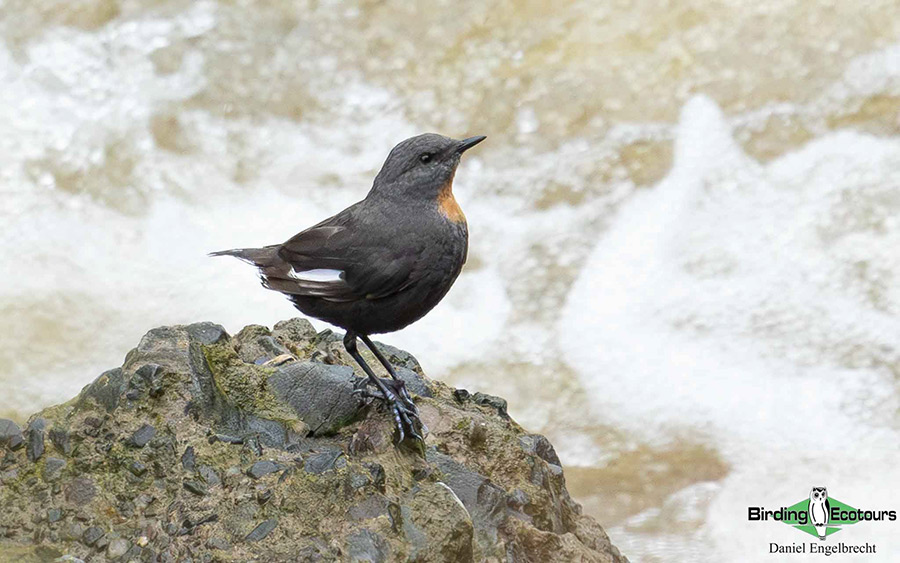
The world’s most range-restricted dipper: the charming Rufous-throated Dipper.
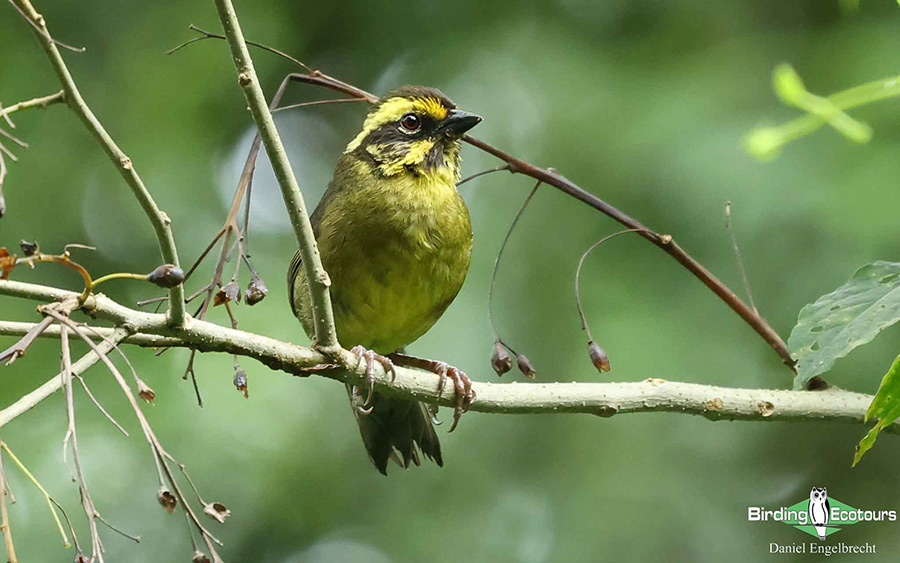
The endemic Yellow-striped Brushfinch treated us to fairly close views along the Rio Sosa.
Dique la Angostura was an absolute mecca for waterbirds and from the shoreline, we racked up an impressive list of species. We even managed to find three local rarities here: a White-tailed Kite, a Least Grebe and a couple of Snowy-crowned Terns (that were breeding here and had fledglings!). Non-rarity highlights included Patanal Snipe, Andean Goose, Cocoi and Little Blue Heron, White-tufted and Great Grebes, hundreds of ducks including Cinnamon Teal, Lake Duck and Andean Duck and a group of Coscoroba Swans. Scanning through different coot species was a new sensation for me, and we picked out Red-gartered, White-winged and Andean Coots. The grassy lake edges played host to lots of pipits, and we managed to identify three species: Yellowish, Correndera and Short-billed (the latter expertly picked up by Daniel).
The stunning Infiernillo Pass ascends north of the town through cattle pens and lush green slopes before peaking and descending into the dry cactus-strewn scrub of the Monte Desert. A gulley near the top of the pass produced three Argentine endemics: Tucuman Mountain Finch, Moreno’s Ground Dove,and White-browed Tapaculo, as well as Buff-breasted Earthcreeper, Cream-winged Cinclodes, Plain-colored Seedeater, White-browed Chat-Tyrant, a showy Ornate Tinamou and an even showier Andean Tinamou. Other highlights from the lush side of the pass included our first views of Andean Flicker and our only views of Black-winged Ground Dove.
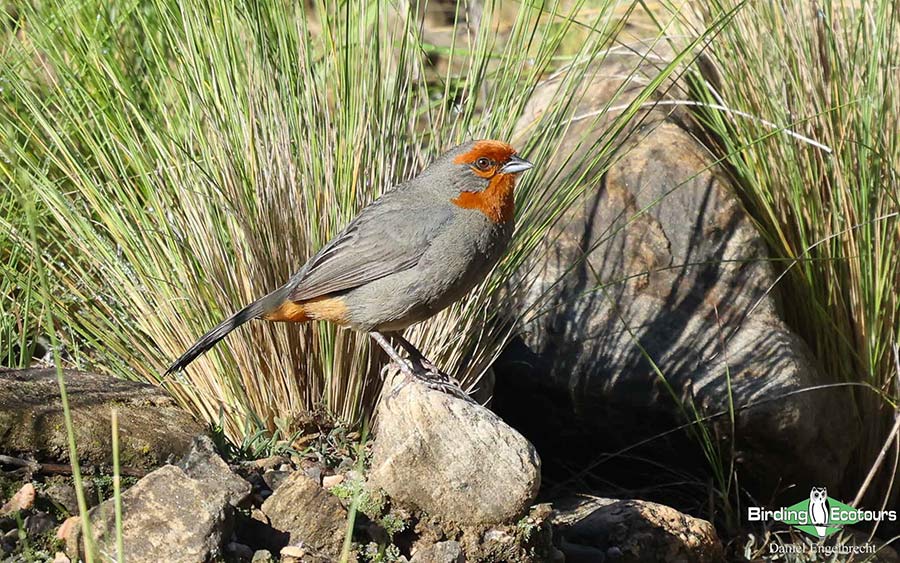
The handsome Tucuman Mountain Finch treated us to incredible views on Infiernillo Pass.
The drier, north side of the pass gave us a completely new set of birds, including some introductory Monte specials. One of our targets in this habitat, the Monte Yellow Finch, proved difficult to find amongst the many similar Greenish Yellow Finches in the area and only provided distant and brief visuals. Fortunately we had plenty of other great birds to make up for it, namely Giant Hummingbird, Andean Hillstar, Grey-hooded Parakeet, Spot-billed Ground Tyrant, D’Orbigny’s Chat-Tyrant, Rufous-banded Miner, Cordilleran Canastero, Plain-mantled Tit-Spinetail, Diuca Finch, Mourning Sierra Finch, Black Siskin and flocks of Burrowing Parrots flying overhead.
During our time spent in the Monte, between the towns of Amaicha del Valle and Cachi, we cleaned up on all of our main targets, with the main two, Sandy Gallito and White-throated Cacholote showing exceptionally well. We also were surprised to find a Black-crowned Monjita (said to not be around at that time of year by local birders) and got more, but still brief, views of Elegant Crested Tinamou. The wetlands and wine country between the stark rocky desert valleys in this area also proved productive, delivering goodies like Subtropical Doradito and Red-fronted Coot. A small group of the localized Rothschild’s Swift as we left Cachi was also a great find.
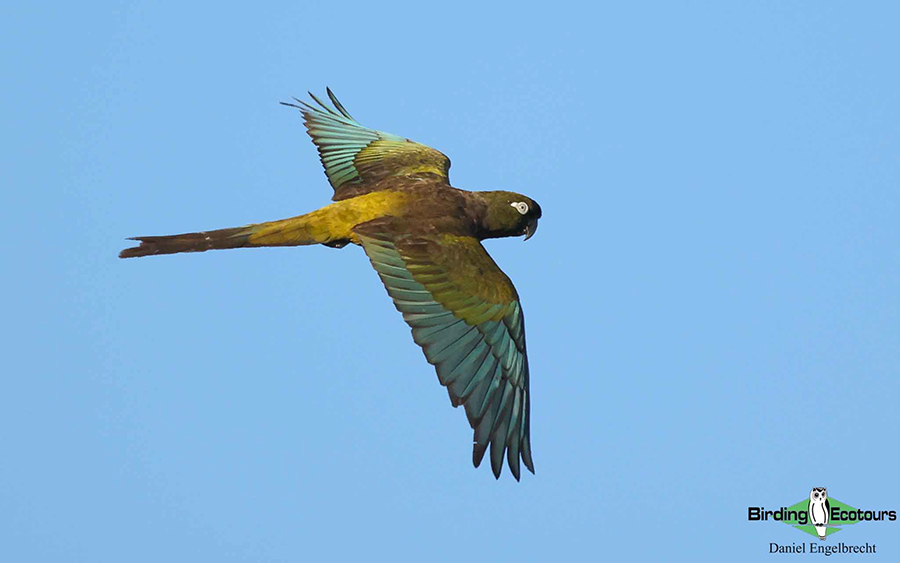
The spectacle of some 300 Burrowing Parrots getting ready to roost was unforgettable.
Moving east from the Monte back into the mountains, we were greeted by another pass: Cuesta del Obispo. The dry flats of Cardones National Park, west of the pass, treated us to Tawny-throated Dotterels, Least Seedsnipes and our first Andean Lapwings and Mountain Caracara of the trip, as well as herds of Guanacos. From there, we started the ascent and were treated to the most spectacular vistas over the dramatically steep slopes that this pass winds through. From top to bottom, we amassed yet another round of delectable species, of which new additions were Rufous-bellied Mountain Tanager, Rock Earthcreeper, Maquis Canastero, Zimmer’s Tapaculo, Black-backed Grosbeak and Scribble-tailed Canastero. We also improved on our views of Mitred Parakeet from the Yungas and Band-tailed Sierra Finch from Cordoba. However, our biggest score had to be an Andean Mountain Cat near the top of the pass. Very few people have seen this little-known mammal, so we were extremely lucky and privileged to have glimpsed one on this trip.
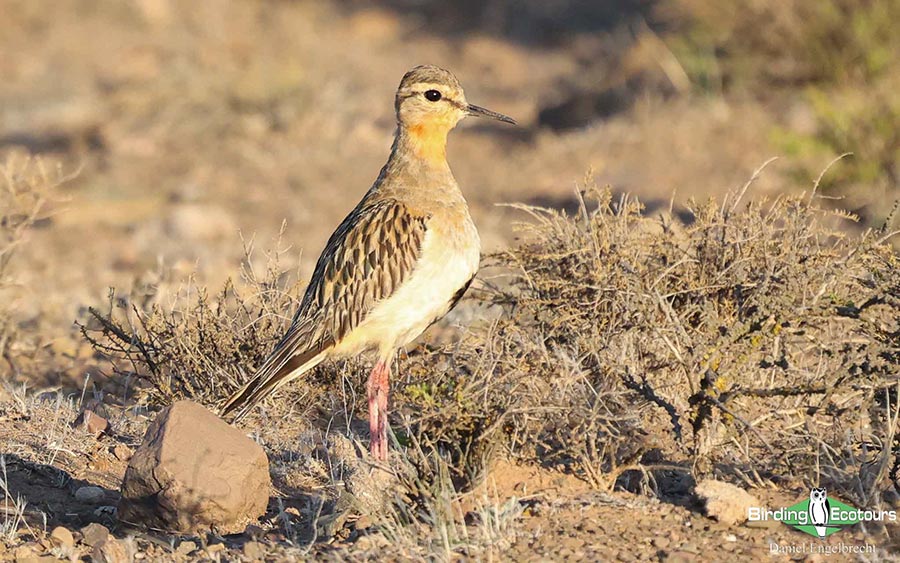
The plains of Cardones National Park were home to the bizarre Tawny-throated Dotterel.
Next stop was an overnight on a farm near the town of Salta. Situated in the lush hybrid zone of Yungas forest and Humid Chaco, this area is particularly rich in species, and the farmer, Oliver Kohler, an avid birder himself, took us around his property to show us some cool species. Scaly-headed Parrot, Greenish Elaenia, Orange-headed Tanager, Great Rufous Woodcreeper, Streaked Xenops, Purple-throated Euphonia, Variegated Flycatcher, Two-banded Warbler, Swainson’s Thrush, Southern Tropical Pewee, Rufous-fronted Thornbird, White-winged Becard, Mottle-cheeked Tyrannulet, Southern Mouse-colored Tyrannulet, Yungas Sparrow and Ruddy Ground Dove were all new additions to the trip list that we saw on his farm.
We also managed to flush a Huayco Tinamou upon our arrival at the farm. At night, the farmer took us out on a long walk to look for owls, preceded by more Rothschild’s Swifts flying overhead. Although we heard multiple Buff-fronted Owls, none of them seemed willing to investigate our playback. However, an excellent consolation prize was a Yungas Screech Owl, a Yungas endemic and major target for us. The last great find was a pair of Red-legged Seriemas strutting down the road as we left the farm the following day.
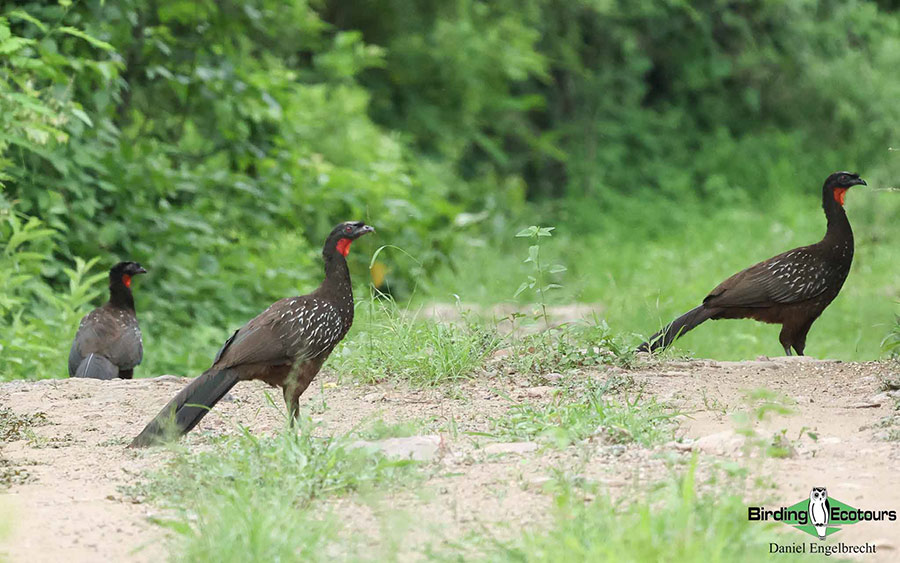
The antics of groups of large Yungas Guans were quite entertaining.
The pinnacle of forest birding on this trip occurred at Calilegua National Park, three hours north of Salta. This park contains vast tracts of untouched Yungas Forest, and includes both lowland humid forest around the entrance and cooler, high-altitude cloud-forest further up the main track. We spent most of our time in the higher cloud-forest where we delighted in such treats as White-throated Antpittas (visuals of at least three individuals!), Speckled Nightingale-Thrush, Blue-crowned Trogon, Fulvous-headed Brushfinch, Planalto Hermit, Buff-banded and Sclater’s Tyrannulets, Dot-fronted and Smoky-brown Woodpeckers, Plumbeous Tyrant, Crested Becard, Speckled Hummingbird and flocks of Green-cheeked and Mitred Parakeets. This was also where the many White-tipped Doveswe had been seeing throughout the trip were replaced by the similar Yungas Dove.A pre-dawn start in the cloud-forests one morning allowed us to finally connect with a Buff-fronted Owl, as well as a bonus in the form of a Black-banded Owl, even though we were once again played by a different species: Yungas Pygmy-Owl, which we heard but did not see. Raptors also abound in this reserve, with sightings of Plumbeous Kite, Bicolored Hawk, Rufous-thighed Kite, Black-and-chestnut Eagle and flocks of Swallow-tailed Kites (one containing at least 30 birds!).
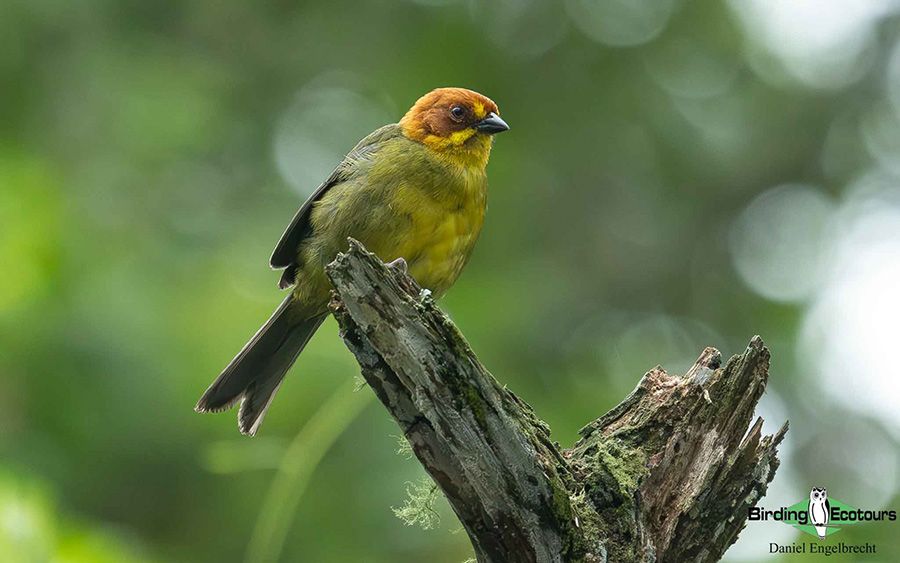
One of the many cloud-forest specials seen in Calilegua was the Fulvous-headed Brushfinch, a Yungas endemic.
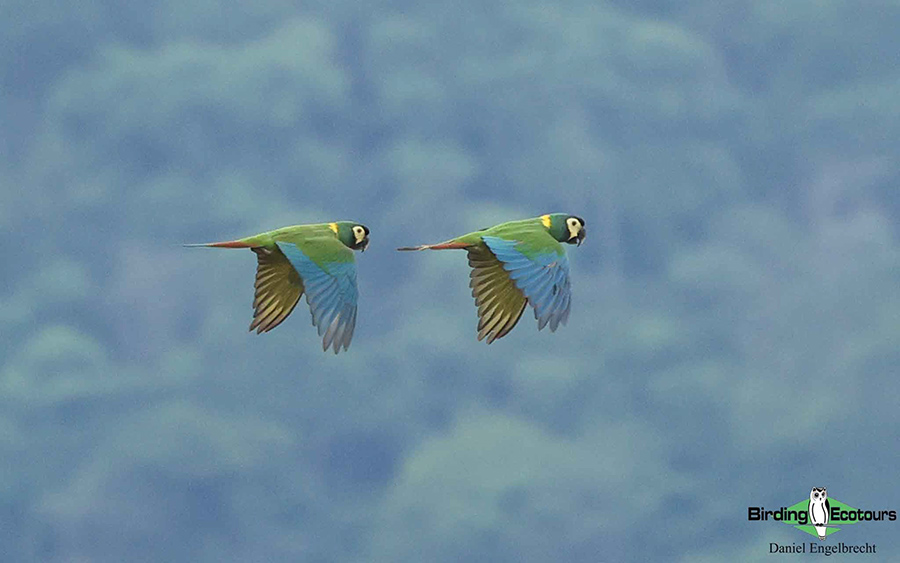
My first macaw: the Golden-collared Macaw, seen flying over the Rio San Lorenzo.
The lower-lying, humid forests were less productive in terms of regional specials, but we still found great birds like Amazonian Motmot, Pale-vented Pigeon, Ochre-cheeked Spinetail, Ochre-faced Tody-Flycatcher, the iconic Toco Toucan, flocks of Sick’s Swifts flying overhead and loud Golden-collared Macaws. A small black chick running across the track also led us to brief views of its parent; a Tataupa Tinamou flushed from the roadside! The river between the park and the town of San Martin also gave us some good birds, including waterbirds like Roseate Spoonbill, Wood Stork, Muscovy Duck and Snowy Egret.
Leaving Calilegua, we headed south and then west towards the high Andes, stopping to bird the cloudy elfin forests near Yala. This is the stomping ground of the localized Red-faced Guan, and after flinching at multiple Yungas Guans, we eventually found a pair of these birds near the top of the Potrero de Yala track. Here, we again scored big time with a male Slender-tailed Woodstar perched near some flowers. This enigmatic little hummer is only found in the Yungas and is quite thin on the ground, so this was a major highlight for us.
The forest birding itself was quite pleasant, and we managed to get improved views of Plumbeous Tyrant, Toco Toucan and Dot-fronted Woodpecker, as well as new birds like Streak-throated Bush Tyrant and the range-restricted Spot-breasted Thornbird.
From Yala, we continued over the mountains, trading the forests for dry Andean scrub, or “pre-Puna”. Basing ourselves in Humahuaca, a few forays we made out into this new habitat revealed interesting birds, such as Brown-backed Mockingbird, Andean Swallow, Common Miner and Rufous-naped Ground Tyrant.
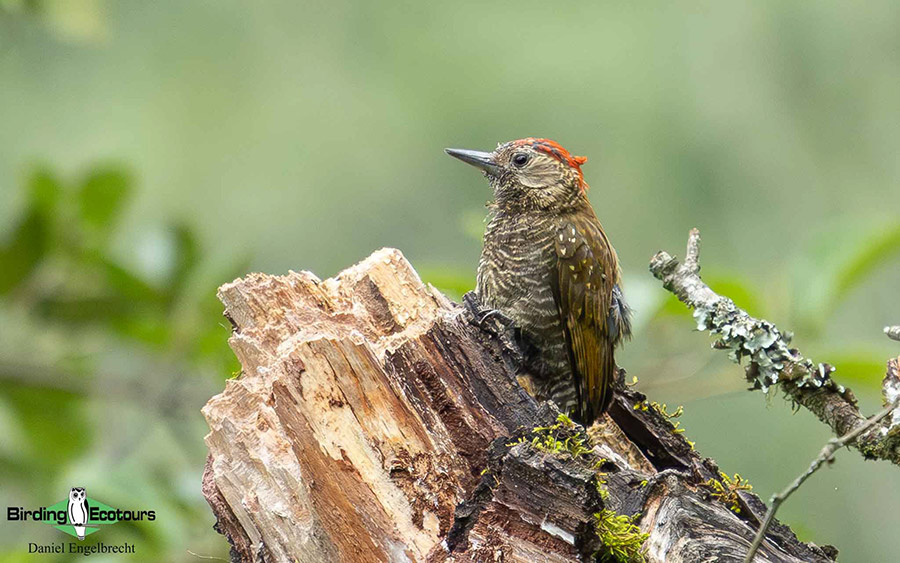
This Dot-fronted Woodpecker at Yala was particularly confiding, more so than they had been at Calilegua.
From Humahuaca we pushed on northwards, making a few stops near the town of Abra Pampa. Small wetlands near the town gave us our first taste of Andean waterbirds, including Crested Duck, Giant Coot, Puna Teal, Andean Avocet, Chilean and Andean Flamingos, Wilson’s Phalarope and Yellow-billed Teal (these being of the pale-bodied subspecies of higher altitudes, sometimes split from the nominate). Other interesting target birds seen around Abra Pampa included Andean Negrito, Puna Miner, Bright-rumped Yellow Finch, Puna Pipit, Mountain Parakeet, Cinereous Harrier, and Wren-like Rushbird.
Journeying northwest of Abra Pampa (picking up Puna Yellow Finch along the way), we set our sights on the immense Laguna de los Pozuelos. This high-lying salt lake is roughly nine miles across and is home to over 100,000 flamingos of three species: Chilean, Andean and, most importantly for us, James’s Flamingo. Seeing the sheer size of this lake in person, with the pink, hazy horizon formed by thousands of flamingos, has to be one of the most memorable experiences of the trip, and a must-see for any global birder! The shoreline of the lake provided us with a few Puna Plovers among the masses of Baird’s Sandpipers that were thronging the mudflats.
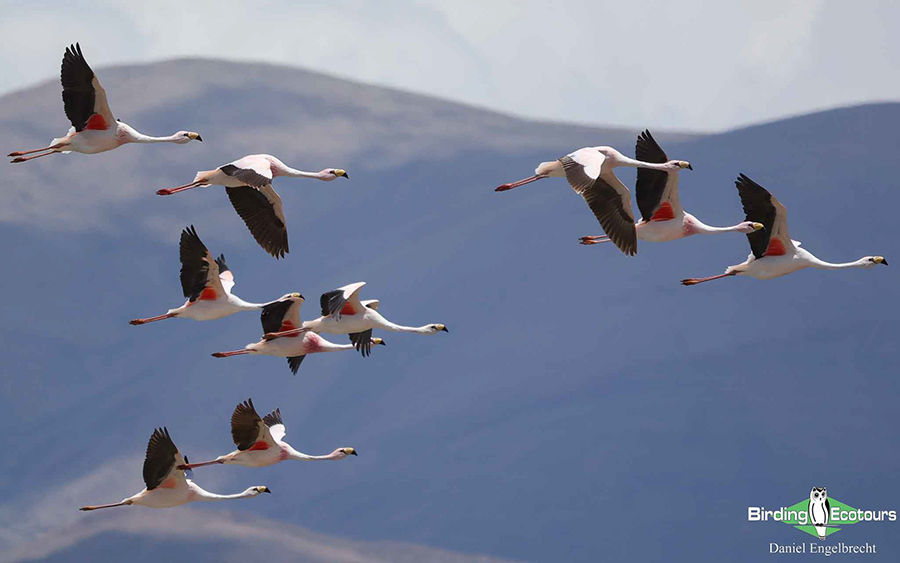
Of the three species of Flamingo at Pozuelos, James’s Flamingo was the least common.
Our final stop on the outbound journey was the village of Yavi, ten miles east of the border crossing at La Quiaca and situated right on the Bolivian border. This quaint Andean settlement had three major targets for us that we saw shortly after arriving: Bare-faced Ground Dove, Citron-headed Yellow Finch and Wedge-tailed Hillstar. We also visited the nearby Abra de Lizoite pass during our time in Yavi, reaching our highest altitude of the trip at 4,500 meters. The rocky slopes along the pass delivered Straight-billed Earthcreeper and Cinereous and Puna Ground Tyrants, while we searched the boggy stream-gullies here for Diademed Sandpiper-Plover. The latter did not, however, reveal itself, but we did manage to find Red-backed Sierra Finch, Andean Hillstar, White-winged Cinclodes and Grey-breasted Seedsnipe. Seeing large groups of Andean Condors flying below us was also a spectacle we enjoyed.
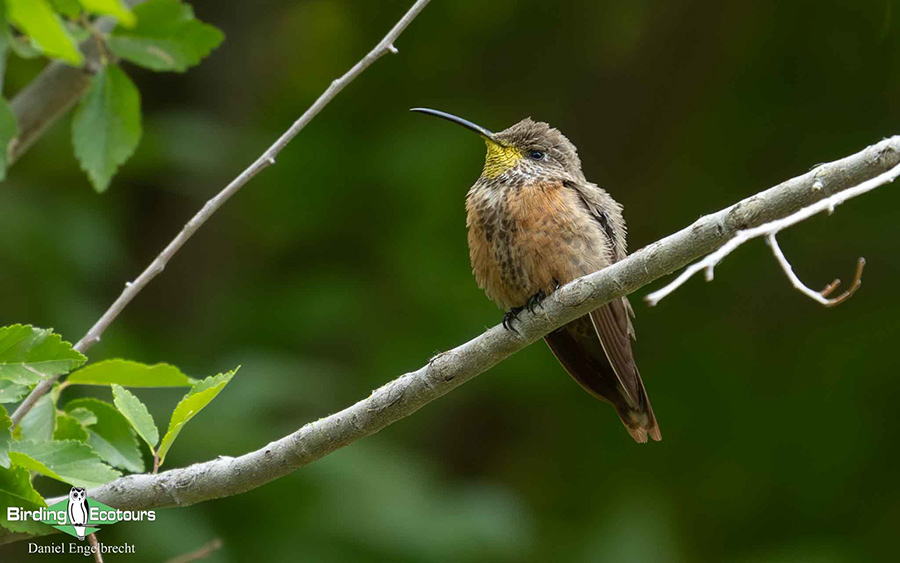
This female Wedge-tailed Hillstar had taken up residence in a garden in Yavi, making it relatively easy to connect with this rare species.
The 3-day return journey to Buenos Aires saw us add few, but very interesting birds to our list, namely Dinelli’s Doradito, Stripe-backed Bittern, Black-necked Swan, Plain Inezia, Yellow-chinned Spinetail, Comb Duck, Great Antshrike and, most remarkably, a magnificent Chaco Eagle perched on a roadside telephone pole. This large grey hawk is an endangered endemic of the Chaco and Caatinga woodlands, and we did not even get our hopes up about finding one. This was a momentous sighting and was unanimously voted “bird-of-the-trip” by the end of our journey.
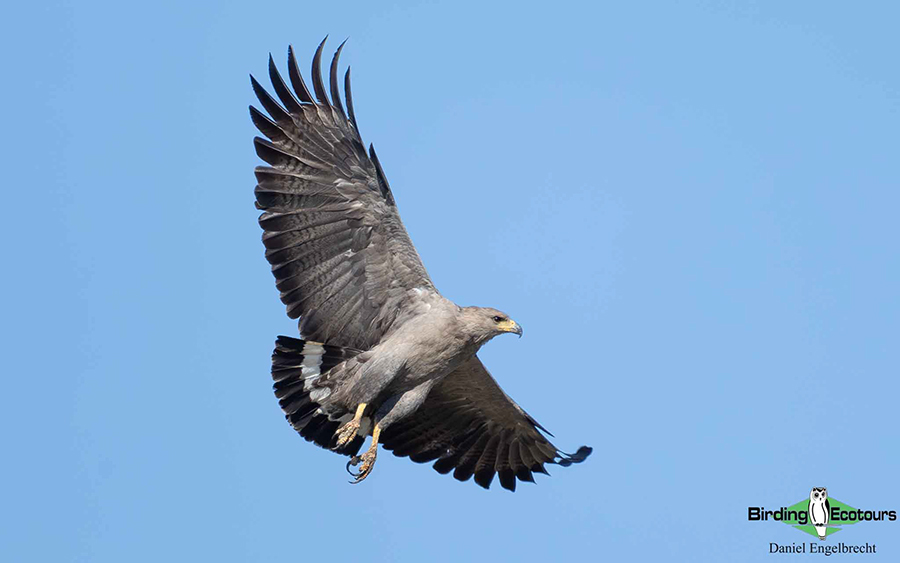
This Chaco Eagle really stole the show for us, right at the end of the trip!
Concluding our escapade, our last morning of birding in Argentina was spent walking around the Reserva Ecologica Costanera Sur, a large coastal wetland and forest system in the heart of the city. Being just as popular with runners and cyclists as with birders, we still managed to scratch out some new birds for the trip. Highlights included two nesting Rufescent Tiger Herons, Green-winged Saltator, Limpkin and more Variable Orioles.
And so ended what was a phenomenal birding trip in Argentina, one I won’t soon forget. I can’t wait for my second visit to the Neotropics! If you would like the opportunity to see some of these mouth-watering species, check out our Northwest Argentina tour. If you enjoy endemic-rich regions with a high diversity of species found across different habitats, this is definitely a tour that you want to consider!
Ready to experience the wild diversity of Argentina for yourself?
With over 1,064 bird species, including 16 endemics, Argentina is not to be overlooked among the more well-known Neotropical birding destinations. Our tours focus on tracking down the region’s most sought-after species — with expert local guides who know the birds best.
Some of the standout species that can be seen on our Northwest Argentina tour include:
Rufous-throated Dipper, Diademed Sandpiper-Plover, Sandy Gallito, Red-faced Guan, Tucuman Mountain Finch, Moreno’s Ground Dove, Red-tailed Comet, Wedge-tailed Hillstar,the attractive Burrowing Parrot, White-throated Antpitta, Tucuman Amazon, Lyre-tailed Nightjar, Giant Antshrike, Black-legged Seriema and Black-bodied Woodpecker.
Browse all our Argentina birding tours here:
https://www.birdingecotours.com/destination/argentina-birding-tours/
Or email us at [email protected] and let us help you plan the perfect trip.
